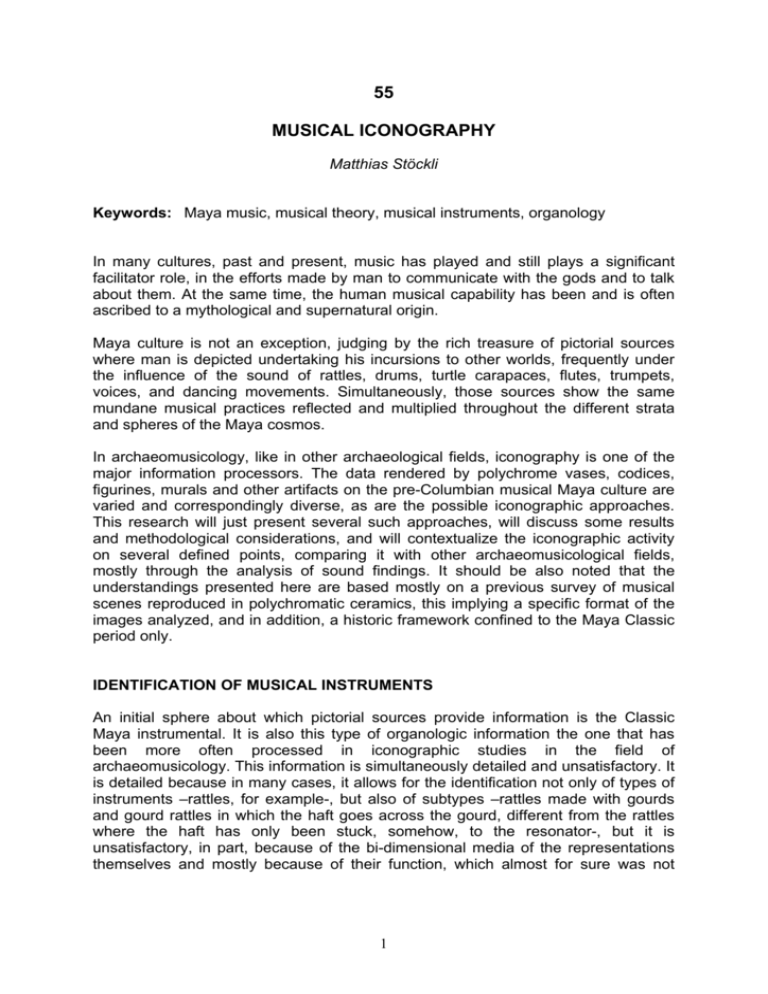55 musical iconography
advertisement

55 MUSICAL ICONOGRAPHY Matthias Stöckli Keywords: Maya music, musical theory, musical instruments, organology In many cultures, past and present, music has played and still plays a significant facilitator role, in the efforts made by man to communicate with the gods and to talk about them. At the same time, the human musical capability has been and is often ascribed to a mythological and supernatural origin. Maya culture is not an exception, judging by the rich treasure of pictorial sources where man is depicted undertaking his incursions to other worlds, frequently under the influence of the sound of rattles, drums, turtle carapaces, flutes, trumpets, voices, and dancing movements. Simultaneously, those sources show the same mundane musical practices reflected and multiplied throughout the different strata and spheres of the Maya cosmos. In archaeomusicology, like in other archaeological fields, iconography is one of the major information processors. The data rendered by polychrome vases, codices, figurines, murals and other artifacts on the pre-Columbian musical Maya culture are varied and correspondingly diverse, as are the possible iconographic approaches. This research will just present several such approaches, will discuss some results and methodological considerations, and will contextualize the iconographic activity on several defined points, comparing it with other archaeomusicological fields, mostly through the analysis of sound findings. It should be also noted that the understandings presented here are based mostly on a previous survey of musical scenes reproduced in polychromatic ceramics, this implying a specific format of the images analyzed, and in addition, a historic framework confined to the Maya Classic period only. IDENTIFICATION OF MUSICAL INSTRUMENTS An initial sphere about which pictorial sources provide information is the Classic Maya instrumental. It is also this type of organologic information the one that has been more often processed in iconographic studies in the field of archaeomusicology. This information is simultaneously detailed and unsatisfactory. It is detailed because in many cases, it allows for the identification not only of types of instruments –rattles, for example-, but also of subtypes –rattles made with gourds and gourd rattles in which the haft goes across the gourd, different from the rattles where the haft has only been stuck, somehow, to the resonator-, but it is unsatisfactory, in part, because of the bi-dimensional media of the representations themselves and mostly because of their function, which almost for sure was not 1 intended to reproduce every single detail for some subsequent organologic and acoustic reconstruction of the instruments depicted. The comparison of the organologic information possible to obtain through field archaeology with that obtained through iconography, ratify that pictorial sources are witness to the existence of a wide range of musical instruments, which, apparently, have not physically survived. On the other hand, there is a whole series of sound artifacts that are abundant in archaeological findings, though they are almost absent in pictorial sources, like flutes in the shape of figurines, or in general, clay flutes. One exception to this is possibly found in [Kerr Number] K5435, where a man has been represented standing or probably seating on the tiers of a Ballgame holding an artifact in his hands which could well be a figurine-flute. This man, anyway, forms some kind of duet with his partner at his left who is shaking some chinchines (rattles), and both appear to be having a good time, in addition to singing, shouting or making comments on the game (Reents-Budet 1994:265). While the absence of many types of musical instruments in archaeological contexts finds an explanation, though partial, in their quality of perishable materials, the lack of depictions of clay flutes must refer us to the existence of a field of musical and cultural activities that obviously were not considered worth representing. Without wanting to engage in a discussion about the possible functional and social reasons for this absence of representations, it is evident that the musical culture of the Maya was segmented, and that the instrumental differentiation observed probably marked a dividing line between two of those segments. In overall terms, physical archaeology and iconography provide complementary information about the Maya instrumental. However, two major intersections exist: • One, consisting mainly of clay drums, turtle carapaces and shell trumpets, transmitted both in the form of artifacts and representations. • The other, within the framework of a symbol of systems common both to painted musical scenes, and modelled sound figurines. IDENTIFICATION OF EXECUTION TECHNIQUES The direct observation of musical instruments in action is not, for obvious reasons, within the reach of archaeomusicology. But, iconography provides some opportunities for an indirect observation not only of the techniques of execution, but also of the treatment given to musical instruments whenever they were not played but for example, simply carried. In regard to the techniques of execution, the pictorial representations, in addition to providing basic information –trumpets or flutes were blown with the mouth, drums were more commonly beaten with the hands- are at times pretty rich in details. Thus, it may be assumed that the long trumpets of those times were played in a variety of positions: seating, lying on the knees, standing, walking, dancing possibly, 2 pointing diagonally upwards or downwards, while many such positions involved specific contextual connotations; it was possible to observe as well that the drums of the huehuetl (pax) type were not simply beaten with the palm of both hands but also with the arched hands, or even with the fingers (for example, K3009). While the simultaneous analysis of objects and actions related to them may lead quite easily to conclude that the scene depicted is about a musical activity –errors are not excluded in some ambiguous cases-, the identification of vocal sound production presents much more difficulties; this is because of the simple fact that a good portion of this activity takes place secretly, and therefore, it is not easy to be represented visually. This is one of the reasons why that kind of sound production has not been given an attention in archaeomusicological studies, adequate to the significance it probably had in the framework of the musical practices of those times. Anyway, there are certain signs which seem to point to a vocal activity; certain types of scrolls emerging from a mouth are one of them (Houston and Taube 2000), and another one is an open mouth, as such. Both signs are somewhat ambiguous, but nonetheless, the presence of at least one of them in a scene, together with its concomitant contextual analysis may lead at least to the presumption that in fact, some vocal activity is taking place. The question that remains unanswered is what precise type of vocal activity we are talking about. Anyway, it would be enough to say that ethnomusicology may teach us that expectations in that respect may hardly be wide, and that a vast range of vocal and linguistic forms –singing with our without lyrics, reciting, praying, yelling, buzzing, grunting, bellowing, whispering, panting, groaning, etc- may become the representations of a musical and ceremonial universe of communications in a given culture. IDENTIFICATION OF MUSICAL ENSEMBLES Another important question for the understanding of the social, textual and contextual organization of the musical culture of the Maya has to do with the possible combinations of instruments –even the vocal chords- engaged, and the identification of musical ensembles. If an ensemble is understood like a group of musicians with some social persistence, which by means of a permanent set of instruments performs some musical text and conducts specific contextual actions, then it is possible to observe, in the frequent presence of certain instrumental combinations in pictorial sources, at least an indication of the existence of such ensembles in that culture. One such combination of instruments includes a huehuetl type of drum, the carapace of a turtle, and two rattles (for example, K5104). Usually represented as a group of three soloists, a multiple cast in at least one of its sections might have been also possible, as shown in the mural of Room 1, Structure 1, at Bonampak (Ruppert et al. 1955). Other variants of the ensemble have to do with the replacement of the huehuetl by a clay drum, the aggregate of one possibly wooden drum of the tun or teponaztly type played with one single drumstick, or the reduction of the instruments to two (for example, K1563, K3007). 3 Moreover, the members of the ensemble –in addition to playing their instrumentsfrequently appear to be involved in vocal activities. Finally, each one of the three instruments is also represented on its own or combined with other types of instruments. It should be noted that within the field of combining the possibilities so succinctly circumscribed here, the precise status of many of their individual positions –is it an ensemble in its own sense, or in fact is it some variant of a model ensemble?-, may hardly be ascertained based only on iconographic analysis, and to a lesser degree whenever such analysis is limited to verifying instrumental combinations leaving aside the contexts of the scenes where they are represented. The fact that the terms “instrumental combination” and “ensemble” are not always congruent is evident in those cases where in certain scenes, the combination of instruments played apparently at the same time and at a same place seems to be formed not by one but rather by several ensembles. In references found in iconographic literature regarding the musical practices of the Maya, the instrumental groupings are usually sensed as an entity and named as such, for example as an orchestra, band, or a procession of musicians. However, some representations call for a more differentiated reading. In examining, for example, the spatial position of the musicians in K2781, it becomes obvious that they are divided into two groups that are playing from behind: that of the trumpet players whose activity is directly connected with the events on the scaffold, and that of the three musicians that play chinchines, huehuetls and turtle carapaces, who obviously form the rear part of the group of those who carry the spears. Actually, this is the representation of two different ensembles playing at opposite sides of the scene, and their presumed immediate closeness is but a visual illusion created for the format that supports the image. Something similar is apparently suggested in the disposition of figures in the presumed processional march of the Bonampak mural, mentioned earlier, where the group of actors-dancers with masks clearly separates an ensemble of musicians with chinchines, huehuetls and turtle carapaces from an ensemble of trumpeters. In this case, both groups of musicians are also differentiated by their costumes. Mary E. Miller (1988), examining these two same scenes, points to the possibility of a certain divisibility of the musical groupings, without definitely concluding that in fact they were the representation of more than just one single band. This presumption has not been corroborated, but it is being additionally favoured because of the fact that the same phenomenon is present in the contemporary Maya musical practice – like in many other contemporary and historic cultures- where often, many ensembles participate in the processions or patron saint celebrations, who by playing simultaneously and sharing narrow spaces produce altogether a sort of sound and social meta-text with specific meanings. Despite its apparent disorder and cacophony, these coincidences are strictly structured, and the groups, to put it in a simple way, may be disassembled at any given time into their component parts or individual ensembles, as social and musical autonomous entities. 4 VISUAL SONORITY All of the above depends, naturally, on the possibility of visually representing and identifying certain aspects of the musical phenomenon. However, the function of images present in artifacts and the activities identified as of a musical nature was probably not limited to transmitting organological, sociological or any other type of information, but at least, it was probably intended to refer to something that in fact was out of reach for the visually reproducible, in other words, sonority itself. But, contrary to the current observer, one that in seeing a musical scene may at the most grasp some idea of the sounds produced by the instruments and ensembles reproduced, both the artist and the observer of those days probably had, potentially at least, some knowledge that enabled them not only to connect the visual impression with a precise idea of musical structures, but also to complement the reading of visual symbols with their understanding of the contemporary sound symbolic system. An additional challenge regarding the visual representation of music is the transformation of “time” –major means of its perception- into “space”. The problem is not limited, of course, to the musical time, but it rather has to do with the representation of any type of sequential event. It needs to create the illusion of time elapsing in a basically still media, something that is achieved in different ways in the pictorial sources. One of them consists in representing moving sequences by showing the production of series of sound impulses: to paint, for example, the hands of a musician beating a drum or shaking the chinchines in two different positions. Another way consists in showing the effect of music on musicians or dancers, by representing them coordinating their body movements throughout time, possibly following some musical tempo (for example, K2108, K1549). A different way to visualize the musical time is revealed in a funerary vessel described by Nicholas Hellmuth and baptized as the Delataille Tripod or Belgian Tripod (Hellmuth 1988). According to Hellmuth, the scene reproduces the long and complex body transformation of a royal lord in the underworld after his death. The interesting part is that the beginning and the end of his transformation are marked by the reiterated representation of a pair of chinchines, something that could well lead to the conclusion that these artifacts –and most of all the continuity of the sounds they produced- were considered to be key elements in the temporal development of this kind of metamorphosis. Finally, regularity, repetition and variation are ways of spatial configuration frequently found in pictorial sources, both in the decorative and the figurative spheres. Like these same modes are also more often crucial resources to structure the musical time, it is conceivable that in certain cases such similarity reaches beyond the mere analogy, and that the same modes applied in the spatial media may intentionally refer as well to a musical time (for example, K3649, K6995). In relation with this type of spatial structuring is the frequent motif of a sequence of figures described in literature as a procession. Without trying to deny the applicability of the word in many cases, it is worth considering the possibility of alternative or complementary interpretations. 5 It is conceivable, for example, that they are the mere spatial reflection of a narrative temporal structure (in the sense of, at the beginning this was, or the dog did something and then the toad did it…), of the reference to a choreographic or even musical structure, or also of the representation of a temporal structure in a more abstract sense which should probably be understood in relation to the act of watching a piece of pottery, something involving setting the artifact in motion, turn it around and perceive that which was successively represented. This temporal aspect intrinsic to the perception of ceramics, risks to become lost whenever they are reproduced as rollouts; however, it is probable that the effect of successive visibility was something well calculated. It is almost inferred that all these modes or tricks to turn time into space and space into time, do not work just like that, but that some sort of complicity between the artist and the observer is needed, as well as a common knowledge about creation and the breaking down of the temporal structure of a scene. TRANSFORMATIONS The major problem in any iconographic undertaking with historic or ethnographic aspirations consists in ascertaining which transformations of a functional, esthetical or ideological nature link the representations with the presumably original ones. In the course of this investigation, such transformations have been abundantly noted, and not only in the discussion about the representation of the musical time. Once again referring to the musical instruments, the fact that a drum maintains its appearance independently of whether it is being played by a human being, a god, or a way, makes it probable that the way in which it is reproduced had a strong morphological similarity with the real instruments of those days. But, again, the transcendence of this observation reaches beyond the mere corroboration that the reproductions of musical instruments are truly apt for an organological study. In the fact that such artifacts may be played in the pictorial sources not only by humans but also by supernaturals, a concept seems to be manifesting according to which, these, jointly with the sounds they create, were conceived as some kind of transformative axis between different worlds, being their realistic reproduction the unquestionable confirmation of the veracity of these transformations. And finally, that which is being grasped here through the iconographic analysis of transformations of different kinds is a theory of the Classic Maya music, at least in fragments. REFERENCES Hellmuth, Nicholas 1988 Early Maya Iconography on an Incised Cylindrical Tripod. In Maya Iconography (edited by E.P. Benson and G.G. Griffin), pp. 152-174. Princeton University Press. 6 Houston, Stephen, and Karl Taube 2000 An Archaeology of the Senses. Perception and Cultural Expression in Ancient Mesoamerica. Cambridge Archaeological Journal 10 (2): 261-294. Cambridge. Kerr, Justin n.d. Maya Vase Data Base: An Archive of Rollout Photographs. Consulted at FAMSI’S website. Miller, Mary E. 1988 Boys in the Bonampak Band. In Maya Iconography (edited by E.P. Benson and G. G. Griffin), pp. 318-330. Princeton University Press. Reents-Budet, Dorie 1994 Painting the Maya Universe. Royal Ceramics of the Classic Period. Duke University Press. Durham & London. Ruppert, Karl, J. Eric Thompson, and Tatiana Proskouriakoff 1955 Bonampak, Chiapas, Mexico. Carnegie Institution of Washington, Publication 602, Washington, D.C. 7







